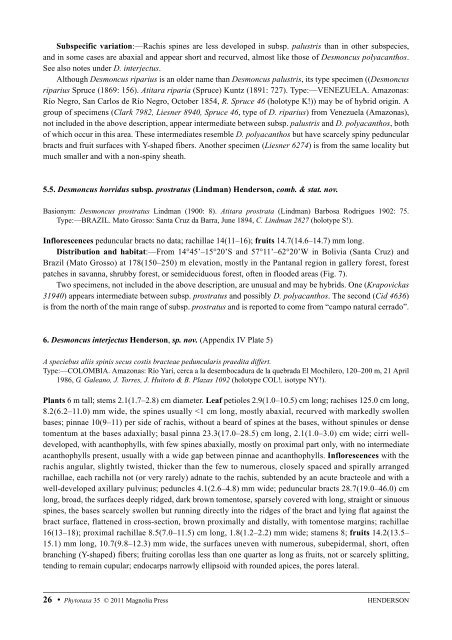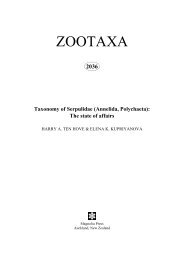Create successful ePaper yourself
Turn your PDF publications into a flip-book with our unique Google optimized e-Paper software.
Subspecific variation:—Rachis spines are less developed in subsp. palustris than in other subspecies,<br />
and in some cases are abaxial and appear short and recurved, almost like those of Desmoncus polyacanthos.<br />
See also notes under D. interjectus.<br />
Although Desmoncus riparius is an older name than Desmoncus palustris, its type specimen ((Desmoncus<br />
riparius Spruce (1869: 156). Atitara riparia (Spruce) Kuntz (1891: 727). Type:—VENEZUELA. Amazonas:<br />
Río Negro, San Carlos de Río Negro, October 1854, R. Spruce 46 (holotype K!)) may be of hybrid origin. A<br />
group of specimens (Clark 7982, Liesner 8940, Spruce 46, type of D. riparius) from Venezuela (Amazonas),<br />
not included in the above description, appear intermediate between subsp. palustris and D. polyacanthos, both<br />
of which occur in this area. These intermediates resemble D. polyacanthos but have scarcely spiny peduncular<br />
bracts and fruit surfaces with Y-shaped fibers. Another specimen (Liesner 6274) is from the same locality but<br />
much smaller and with a non-spiny sheath.<br />
5.5. Desmoncus horridus subsp. prostratus (Lindman) Henderson, comb. & stat. nov.<br />
Basionym: Desmoncus prostratus Lindman (1900: 8). Atitara prostrata (Lindman) Barbosa Rodrigues 1902: 75.<br />
Type:—BRAZIL. Mato Grosso: Santa Cruz da Barra, June 1894, C. Lindman 2827 (holotype S!).<br />
Inflorescences peduncular bracts no data; rachillae 14(11–16); fruits 14.7(14.6–14.7) mm long.<br />
Distribution and habitat:—From 14°45’–15°20’S and 57°11’–62°20’W in Bolivia (Santa Cruz) and<br />
Brazil (Mato Grosso) at 178(150–250) m elevation, mostly in the Pantanal region in gallery forest, forest<br />
patches in savanna, shrubby forest, or semideciduous forest, often in flooded areas (Fig. 7).<br />
Two specimens, not included in the above description, are unusual and may be hybrids. One (Krapovickas<br />
31940) appears intermediate between subsp. prostratus and possibly D. polyacanthos. The second (Cid 4636)<br />
is from the north of the main range of subsp. prostratus and is reported to come from “campo natural cerrado”.<br />
6. Desmoncus interjectus Henderson, sp. nov. (Appendix IV Plate 5)<br />
A speciebus aliis spinis secus costis bracteae peduncularis praedita differt.<br />
Type:—COLOMBIA. Amazonas: Río Yarí, cerca a la desembocadura de la quebrada El Mochilero, 120–200 m, 21 April<br />
1986, G. Galeano, J. Torres, J. Huitoto & B. Plazas 1092 (holotype COL!, isotype NY!).<br />
Plants 6 m tall; stems 2.1(1.7–2.8) cm diameter. Leaf petioles 2.9(1.0–10.5) cm long; rachises 125.0 cm long,<br />
8.2(6.2–11.0) mm wide, the spines usually
















